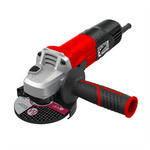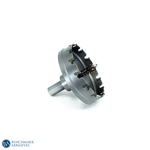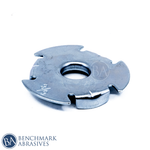
Is Climb Grinding Advisable For a Better Surface Finish?

CNC milling is one of the most well-recognized machining techniques for generating complex pieces. One of the first things an operator has to decide when milling a part is whether to employ climb milling or conventional milling. The main distinction between climb and traditional milling, despite their apparent similarities, is how the cutting tool rotates in proportion to the workpiece's movement.
When talking about climb grinding, it's essential to remember that the term is more frequently used in the context of climb milling. However, the fundamental ideas of how surface polish is impacted by cutting action also apply to grinding.
What Is Climb Milling?
Climb milling, sometimes called down milling, refers to the machining process that involves the cutting tool's rotation moving in the same direction as the feed of the workpiece. This shows that the cutter climbs onto the material, beginning with the thickest chip and then gradually reducing it. This method has several benefits, which include less tool wear, more effective chip evacuation, and a smoother surface finish due to the reason that the chips are aimed behind the cutter.
To avoid the cutter gripping the workpiece and causing damage, machines with low backlash are necessary. In essence, climb milling is a technique that emphasizes accuracy and effectiveness when removing material, especially in contemporary machining applications.
The Mechanics Of Climb Milling
The following are the mechanisms of climb milling to consider:
-
Direction Of A Cut: when using climb milling, the cutting tool such as grinding wheels, rotates in the same direction as the workpiece’s feed. This indicates that the material is first cut at its maximum chip thickness before being progressively reduced to zero.
-
Chip Formation: this is a crucial factor in achieving a better surface finish as this is the outcome of this cutting action.
-
Force Direction: when using climb milling, the workpiece is pushed towards the machine table by downward-directed cutting forces, which improves stability, mainly on stiff tools.
Impact Of Climb Milling On Surface Finish
Climb milling has a considerable and usually positive impact on surface finish in machining. the following are the factors that impact the finished product.
Reduced recutting of chips
As we mentioned earlier, in climb milling, the chips are directed from behind the cutter. This greatly reduces the possibility of recutting the chips from the cutting tool. Traditional milling, on the other hand, frequently pushes the chips ahead of the cutter, increasing the chances that they will be recut; this direct chip evacuation offers a striking difference.
Recutting these chips will lead to unwanted surface finishes like rough surfaces, scratches, and a coarser finish. Hence, climb milling ensures a cleaner and smoother surface finish by efficiently eliminating this recutting issue and producing a clean and more uniform cut.
Minimized Work Hardening
Climb milling greatly decreases work hardening due to its unique cutting action, which directly improves surface smoothness. When compared to traditional milling, which involves the cutting tool rubbing and shearing the material before making a complete cut, climb milling starts contact with the workpiece at maximum chip thickness and slowly reduces it. The frictional heat and plastic deformation that normally cause work hardening are decreased by this precise, clean cut. Climb milling provides an improved machined surface free from the negative impacts of changed material properties by minimizing the mechanical and thermal stresses that cause work hardening.
Smoother Cutting Action
Climb milling's improved surface smoothness is mostly due to its naturally smoother cutting action. Climb milling starts with the maximum chip thickness and progressively reduces it, in contrast to traditional milling, where the cutter encounters the material with increasing chip thickness. By gradually reducing the cutting force, chatter and vibrations are reduced, and the cutting process becomes more stable and regulated.
Climb milling provides a more even and consistent cutting action by effectively minimizing these vibrations, which offers a much smoother and better surface finish. This stability not only improves the aesthetic appeal of the workpiece but also enhances its effectiveness by minimizing surface imperfection, which results in premature wear or failure.
Heat Dissipation
In climb milling, the cutting action of the chip thickens beginning at its maximum and gradually decreasing, the heat is effectively transferred away from the workpiece. As the chip builds up, it eliminates a significant amount of the heat generated during the cutting process. This is not the case with traditional milling, where the rubbing and shearing action causes heat to build up in the workpiece.
Climb milling decreases thermal deformation and lowers the possibility of thermal damage to the machined surface, such as discoloration or microcracking, by quickly removing heat. The workpiece's overall quality and dimensional precision are improved by this regulated heat dissipation, which also helps to provide a smoother surface finish.
Factors Influencing The Outcomes Or Surface Finish
The following are the factors that can influence the outcomes or negatively affect the surface finish:
1. Machine Rigidity
In climb milling, machine rigidity is a crucial factor due to its direct impact on the achievable surface finish. To avoid vibrations and deflection, the natural downward cutting forces in climb milling require a strong and reliable machine frame. Any backlash or flex in the machine’s part like the table, spindle, or lead screws will lead to flaws on the workpiece’s surface. These flaws will eventually damage the required surface finish and show up as uneven surfaces, dimensional errors, and chatter marks.
A firm or rigid machine setup will make sure that the cutting tool keeps consistent contact with the workpiece, reducing unwanted motions and vibrations. This allows a smoother, more regulated cutting action, which results in a superior surface finish and improved quality of the component. Hence, to get the most out of climb milling, you must invest in a rigid machine and ensure that it is maintained properly.
2. Material Properties
Material properties play a crucial role in evaluating the effectiveness of climb milling and the final surface finish. Ductile materials like aluminum and mild steel frequently benefit from climb milling because of their ability to generate clean chips and endure the downward cutting forces. Their fast chip evacuation and decreased work hardening result in smoother surfaces and better dimensional accuracy.
Brittle materials like cast iron or hardened steel, on the other hand, require careful handling when using climb milling. These materials may chip or fracture if the cutting tool is abruptly engaged at maximum chip thickness, which would result in a subpar surface finish. Conventional milling or other machining techniques might be more appropriate in these situations. Hence, a better understanding of the material's properties is necessary for choosing the right milling technique and maximizing cutting parameters to obtain the required surface finish.
3. Quality of a tool
The quality of a tool is an essential factor in getting a superior surface finish while using climb milling. The material, sharpness, and design of the cutting tool directly affected the cutting motion and the desired surface texture. A sharp cutting edge reduces cutting pressures and eliminates the possibility of tearing or smearing the material, which results in a smoother finish.
High-quality tool materials including carbide or coated carbides provide enhanced wear resistance and heat dissipation, enabling quick cutting rates and extended lifespan, both of which lead to a smooth and consistent surface. Therefore, it's good to invest in good-quality tools, and maintaining its sharpness is required for increasing the benefits of climb milling and for getting the required surface finish.
4. Backlash
Backlash is a highly effective part of getting a smooth surface finish. Workpieces are pulled into the cutter by the cutting forces during climb milling, and any backlash in the feed system may cause the workpiece to "jump" or move briefly. Because of the unequal chip thickness caused by this uncontrolled movement, there are chatter marks, uneven surfaces, and dimensional errors. This problem has been somewhat lessened by contemporary CNC machines that are outfitted with backlash adjustment systems and precise ball screws.
Backlash is still a serious issue with older or heavily worn equipment, though. Careful machine maintenance, such as routine lubrication and lead screw adjustment, is crucial to reducing its impact. Backlash can also be lessened by employing slower feed rates and lowering cutting pressures.
Climb milling's ability to generate an excellent surface finish starts with its clean-cutting actions, effective chip evacuation, and minimized work hardening. However, it's crucial to make sure that the machine and workpiece configuration are perfect for this approach.



































































